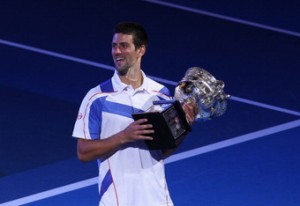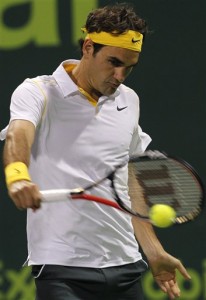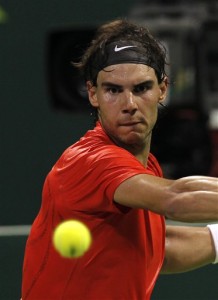A Reversal of Fortunes: Novak Djokovic Derailed Rafael Nadal
A year ago at the conclusion of the 2010 US Open, Rafael Nadal was king of the mountain, having just captured his first US Open trophy and a career grand slam.
He had 10,475 ATP ranking points, leading Roger Federer by 3,260 points, Novak Djokovic by 3, 810 and Andy Murray by 5,350 total points.
Life was good.
Things were definitely looking up for the world No. 1 who had just completed the best summer season of his life on the tennis court.
By the end of 2010 Nadal remained the top dog with 12,450 points leading world No. 2 Federer by 3,305 points, Djokovic by 6,205 points and No. 4 Murray by 6,690 points.
The two top-ranked players were separating themselves from the rest of the pack, and that included No. 3 Djokovic and No. 4 Murray. That meant the continuing Federer-Nadal iron grip at the top was going to be “the” tennis story of 2011.
Or was it?
Heading into the Australian Open, all eyes focused on Federer and Nadal, hoping to see the tennis giants make it through the draw to play each other in another epic final in five sets.
Nadal was poised to become the first man since Rod Laver in 1969 to hold all four grand slam titles at one time. Although not an official grand slam, because the wins were not completed in the same calendar year, it would become a “Rafa Slam.”
![]() A win in Melbourne afforded Nadal a once-in-a-lifetime chance to do something only one man in the modern era had previously accomplished. The world No. 1 was determined to fulfill his destiny.
A win in Melbourne afforded Nadal a once-in-a-lifetime chance to do something only one man in the modern era had previously accomplished. The world No. 1 was determined to fulfill his destiny.
As for Roger Federer, the Swiss had just dominated all players at the 2010 Barclay World Tour Finals in London, winning his fifth championship there. Many expected the world No. 2 to come back strong and win his seventeenth major at the Australian Open.
Ultimately, the 2011 Australian Open brought Nadal no glory after he sustained a hamstring injury during the second game in set one of his quarterfinal match against countryman David Ferrer. Nadal, unwilling to retire as he had in 2009 against Andy Murray, toughed it out, losing to Ferrer is straight sets 6-4, 6-2, 6-3.
Federer on the other hand lost to a very strong, unyielding Novak Djokovic in the semifinals of the Australian Open. It caused fans to recall Djokovic’s 2008 victory over Federer in the semifinals of the Australian Open, only this time Federer was not suffering from the lingering effects of mononucleosis.
This time it was a pure a simple beat-down by Djokovic over the world No. 2.
For Djokovic, it was now his time. His win over Federer at the 2010 US Open semifinals, after losing to the Swiss in 2008 and 2009 at that same stage of the tournament, showed Djokovic was on the brink.
![]() The impetus of his win over Federer during the 2011 Australian Open semifinals helped pushed the Serb over the top.
The impetus of his win over Federer during the 2011 Australian Open semifinals helped pushed the Serb over the top.
Djokovic finally understood he was as good as the two men at the top. After that, the Serb never looked back.
Djokovic went on to surpass Federer, becoming the new world No. 2 at the ATP Masters at Indian Wells. It marked the first time the Swiss was not ranked in the top two since 2004.
In fact, Djokovic did not lose a match in 2011 until Federer defeated him in the semifinals at the 2011 French Open.
In the meantime, Nadal lost five straight finals to Djokovic, including the men’s championship match at Wimbledon in July of 2011.
It also meant that in just a little over a year, Nadal lost his No. 1 ranking––a ranking that seemed utterly secure, even as late as January 1, 2011.
The ranking points melted away from the former world No. 1 as Djokovic began gathering the maximum at each and every tournament they met.
Nadal, however, faced Federer in the 2011 French Open final where the world No. 1 managed to retain his title––the one bright spot of the year.
![]() Currently Djokovic has amassed 13,290 points along with a 61-2 record. He leads world No. 2 Nadal by 1,870 points, No. 3 Federer by 4,901 and No. 4 Murray by 6,755 points. These numbers do not include US Open points that will be awarded at the conclusion of the 2011 tournament held at Flushing Meadows.
Currently Djokovic has amassed 13,290 points along with a 61-2 record. He leads world No. 2 Nadal by 1,870 points, No. 3 Federer by 4,901 and No. 4 Murray by 6,755 points. These numbers do not include US Open points that will be awarded at the conclusion of the 2011 tournament held at Flushing Meadows.
Starting with the 2011 US Open Djokovic will be defending 2,850 points until the end of the year. World No. 2 Nadal has 3,680 points to defend, Federer 3,930 points and Murray 1,805 points.
That means at the end of the US Open, if Djokovic wins, he will have 14,090 points while Nadal will fall to 10,620 points if he makes the final. Otherwise, their point count will not change should Nadal win with Djokovic once again the runner-up.
There is very little doubt but that Djokovic will end the year as the No. 1 ranked player in the world with as comfortable a lead as Nadal had one year ago.
But, as this year proves, change at the top can come in a heart beat.
The question remains––is Djokovic building another Federer-like dynasty, or is he just enjoying a John McEnroe-like year? In 1984, McEnroe compiled a 82-3, winning record, adding 13 singles titles to his tennis resume; but McEnroe fell quickly off the pinnacle in 1985, finally taking a leave from the tour in 1986.
![]() Roger Federer held the No. 1 ranking for 237 consecutive weeks. The man in second place, Jimmy Connors, held the top spot consecutively for 160 weeks. In total, Pete Sampras spent the most time ranked No. 1 at 286 weeks with Federer one week shy of that at 285 weeks. So close.
Roger Federer held the No. 1 ranking for 237 consecutive weeks. The man in second place, Jimmy Connors, held the top spot consecutively for 160 weeks. In total, Pete Sampras spent the most time ranked No. 1 at 286 weeks with Federer one week shy of that at 285 weeks. So close.
Nadal is seventh on the list with 102 weeks. You have to wonder if he will get an opportunity to add more. Will Nadal find his way back to the top again?
After years of sitting behind Federer, Nadal wrestled the No. 1 spot away from the Swiss. More than anything else, Nadal wants to resume his dominance. Federer, at age 30, has much less opportunity to take that top spot back.
It appears that Djokovic, at age 24, has settled in for the long haul. He plans to go nowhere.
Nadal, at age 25, waits for the Serb to falter, to fall off this remarkable pace, because, for the moment, the world No. 2 has no answers to Djokovic on court.
What a difference a year makes.



Whoa! I have been researching yahoo all day with this and i lastly think it is right here!
Aw, this was a really nice post. In concept I would like to put in writing like this moreover – taking time and actual effort to make an excellent article… but what can I say… I procrastinate alot and by no means appear to get one thing done.
Wow that was strange. I just wrote an extremely long comment but after I clicked submit my comment didn’t appear. Grrrr… well I’m not writing all that over again. Anyway, just wanted to say wonderful blog!
About to this new windows7 software for phone. I think, it’s not enough great yet No copy and paste. You’ll be telling me this thing doesn’t run Flash next.What I meant to say what kind of “smartphone” is this ? Does it’s antenna even work?
It’s not working with flash still although It’ll run Adobe flash when Adobe’s done with it. I mean to say they’re just now releasing Adobe flash player for Android phones. It saves the current state of the appz so when you go back to it, it will be where you left it.It doesn’t have ctrl+c. confidently Copy and paste will be changed with smart linking. I hope there will be adding full copy and paste functionality soon.
Have you ever thought about adding a little bit more than just your articles? I mean, what you say is fundamental and all. Nevertheless think of if you added some great visuals or video clips to give your posts more, “pop”! Your content is excellent but with pics and videos, this website could certainly be one of the very best in its field. Excellent blog!
We are a group of volunteers and starting a new scheme in our community. Your site provided us with valuable info to paintings on. You have done a formidable process and our entire group shall be grateful to you.
Hello! I know this is kind of off topic but I was wondering which blog platform are you using for this website? I’m getting sick and tired of WordPress because I’ve had issues with hackers and I’m looking at alternatives for another platform. I would be fantastic if you could point me in the direction of a good platform.
Appreciating the persistence you put into your website and detailed information you offer. It’s great to come across a blog every once in a while that isn’t the same old rehashed information. Wonderful read! I’ve bookmarked your site and I’m including your RSS feeds to my Google account.
Thank you a bunch for sharing this with all of us you actually understand what you’re speaking approximately! Bookmarked. Kindly additionally consult with my site =). We could have a link exchange arrangement among us
Greetings! I’ve been reading your weblog for a long time now and finally got the courage to go ahead and give you a shout out from Austin Tx! Just wanted to mention keep up the great work!
just got backk from dentist, feel shit, need a filling, 10 days before my birthday! -_- there wass this reaaaally fit lad theree thoo ;D|LanaBanana321|
I thought the title, “A Reversal of Fortunes: Novak Djokovic Derailed Rafael Nadal | Sports Then and Now” was a bit misleading. However, the content did not disappoint!
I have learn several excellent stuff here. Certainly value bookmarking for revisiting. I surprise how much effort you put to create one of these excellent informative website.
It?s in point of fact a nice and useful piece of info. I?m happy that you just shared this helpful info with us. Please keep us up to date like this. Thanks for sharing.
Your post, A Reversal of Fortunes: Novak Djokovic Derailed Rafael Nadal | Sports Then and Now was really content rich and straight forward for me to understand.
interesting blog, very resourceful. I like it a lot. I come acoss the blog by Bing search engine. I might read your site oftenly and share it to my classmates. Please keep it fresh. Keep on the good work. – A techie
I’m delighted i have noticed this weblog. Lastly something not just a junk, which we proceed through incredibly frequently. The web site is lovingly serviced and kept up up to now. So that it must be, appreciate your sharing this with us.
I like the way how you demonstrated your language on your post, A Reversal of Fortunes: Novak Djokovic Derailed Rafael Nadal | Sports Then and Now.
lol!
After review a number of the websites in your website today, i genuinely like your method of blogging and site-building. My spouse and i bookmarked the idea to our take a note of internet site checklist and you will be looking at back again shortly. Could you take a look at my site at the same time and also let me know what you consider.
I’ve read several just right stuff here. Certainly worth bookmarking for revisiting. I surprise how a lot attempt you place to create any such magnificent informative website.
Although I really like this publish, I believe there was an spelling error near towards the finish of the third section.
Djokovic my favorite https://bdwebit.com/domain-registration